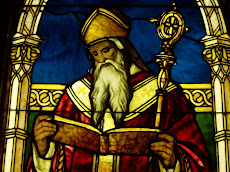This is chapter 2 of part I and it is entitled, "Liturgy - Cosmos - History."
In this second chapter Benedict XVI begins by dismissing as over-simplistic the idea that religions can be divided neatly into "nature religions" that are unconcerned with history and "historical religions" that are unconcerned with the cosmos. Cult and cosmos are bound up together. He also rejects the reading of the Genesis creation narratives which sees the Sabbath as merely a vision of freedom unconnected to worship, that is: "a pure vision of a liberated society as the goal of human history, that from the very beginning is anthropological and social, indeed revolutionary." (25-6) Rather: "The Sabbath is the sign of the covenant between God and man." (26)
Sounding Barthian, Benedict XVI asserts that the goal of creation is the covenant, which he calls "the love story of God and man." (26) This covenant is a relationship and worship is central to this relationship. He notes that in Exodus it says seven times that "Moses did as the LORD commanded him," words that recall the seven day work of creation. At the completion of the Tabernacle, the glory of the LORD filled it. Benedict XVI comments: "The completion of hte tent anticipates the completion of creation. God makes his dwelling in the world Heaven and earth are united." (27) But the purpose of the covenant, he stresses, is not only to save mankind but also to draw the whole of reality into communion with God. Worship is central to God's salvific purposes.
Next Benedict XVI discusses the meaning of sacrifice. Rejecting the idea that its basic meaning is "destruction," Benedict XVI follows St. Augustine in understanding sacrifice to mean "the divinization of creation and the surrender of all things to God: God in all." (28) This means that the purpose of sacrifice (which is the heart of worship) is historical. As he puts it: "Creation is history." (28)
Benedict XVI goes on to differentiate between Gnostic worship and Christian worship. (His clarity of thought is beautiful; a summary does not do it justice.) But to summarize anyway, the difference comes down to the fact that in Gnosticism the basic paradigm is the exitus and reditus, the departure and return. Finitude is a kind of sin, which has to be brought back to the infinite (30) Knowledge is the real power of redemption. (31) Gnosticism is rampant today; it is not merely an historical curiosity. In Christianity, the exitus is "not a fall from the infinite, the rupture of being . . No, exitus is first and foremost something thoroughly positive. It is the Creator's free act of creation." (32) The doctrine of creation as the contingent act of God is a Christian distinctive. The freedom given to the creature means that the creature has the ability to refuse to be dependent and thus to refuse the reditus. "Love is seen as dependence and is rejected. In its place come autonomy and autarchy." (33) This is sin. Now comes a decisively important passage:
"If 'sacrifice' in its essence is simply reuturning to love and therefore divinization, worship now has a new aspect: the healing of wounded freedom, atonement, purification, deliverance from estrangement. . . Worship is directed to the Other in himself, to his all-sufficiency, but not it refers itself to the Other who alone can extricate me from the knot that I myself cannot untie. Redemption now needs the Redeemer." (33)
Benedict XVI thus ties the very process of salvation closely to worship and thereby raises the stakes decisively. Worship is not merely therapy or self-expression or mutual edification. It is the place where God does His sovereign work of redemption and brings healing to the wounded creature. A final word:
"The circles of the cosmos and of history are now distinguished. The gift of freedom is the center of created as well as of divine being, and so the historical element has its own irrevocable meaning, but it is not for that reason separated from the cosmic element. Ultimately despite their differences, the two circles continue to be the one circle of being. The historical liturgy of Christendom is and always will be cosmic . . . Christianity is uniquely new, but it does not spurn the religious quest of human history. It takes up in itself all the prevailing preoccupations of the world's religions, and in that way it maintains a connection with them."
(34)
Subscribe to:
Post Comments (Atom)





No comments:
Post a Comment